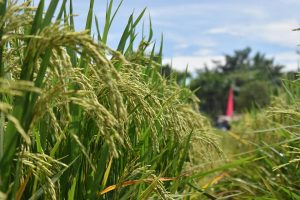 MANILA – The Philippines can be rice self-sufficient in two years if the government succeeds in “reorganizing” the Department of Agriculture (DA) and its attached agencies, President Ferdinand R. Marcos said Wednesday.
MANILA – The Philippines can be rice self-sufficient in two years if the government succeeds in “reorganizing” the Department of Agriculture (DA) and its attached agencies, President Ferdinand R. Marcos said Wednesday.
During a meeting with officials of the DA and the National Irrigation Administration (NIA) in Malacañang, Marcos said he was briefed about the state of the country’s irrigation system.
He said it was during the meeting that he and DA and NIA officials agreed on a “timeline” of steps that need to be taken to achieve their goal of self-sufficiency.
“Sa aming calculation, kung magawa natin lahat ng kailangang gawin kasi marami tayong kailangan ayusin, marami tayong ire-reorganize — pero kung magawa natin lahat ‘yan (Based on our calculations, if we can do everything we need to do, because there’s a lot that needs to be fixed, there’s a lot to reorganize — but if we accomplish them all), we will be close to self-sufficiency for rice in two years,” he said in a video released by the Presidential Communications Office (PCO) to reporters.
Marcos said reorganization efforts require cooperation, convergence and coordination with other agencies such as the DA, NIA, Department of Public Works and Highways (DPWH) and the National Economic and Development Authority (NEDA).
“There’s a great deal of work to do pero nakikita na namin kung papaano gagawin (but we can see how we’re going to do it). So that’s what we will work on for now,” he added.
Earlier, the PCO Secretary Cheloy Garafil announced that Marcos has sought the implementation of a program that will promote the use of hybrid rice varieties to help increase crop production in the country following his meeting with executives of SL Agritech Corp. (SLAC) and farmer representatives from Central Luzon in Malacañang.
During the meeting, Garafil said the SLAC, led by its chairperson and chief executive officer Henry Lim Bon Liong, proposed the conversion of about 1.9 million hectares of rice farming areas planted with certified seeds (CS) to enable the planting of hybrid seeds in four years.
“President Ferdinand R. Marcos Jr. on Tuesday agreed to adopt hybrid rice as a better alternative to the inbred variety for increased crop production. President Marcos said he will implement a program to promote the shift by providing subsidies and facilitating loan financing to farmers,” she said.
Garafil said Marcos also pledged to apply the “best” practices being done by Central Luzon farmers to other areas in the country as part of efforts to strengthen support for rice farmers.
Increasing rice production
Currently, the PCO said that the government has been implementing strategies to increase rice production, such as convincing irrigators associations (IA) and farmers to plant hybrid rice seeds, adopting alternate wetting and drying as a water-saving technology for irrigated lands, harvesting in September during the wet season, and ratooning after harvesting during the wet season.
Ratooning is the agricultural practice of harvesting a monocot crop by cutting most of the above-ground portion but leaving the roots to allow the plants to recover and produce a fresh crop in the next season.
These strategies are meant to complement the Rice Competitiveness Enhancement Fund (RCEF) program which aims to improve the competitiveness of farmers amid the liberalization of the rice trade policy.
The RCEF program was created under Republic Act 11203 or the Rice Tariffication Law.
Likewise, the NIA is implementing several measures to develop the Philippine irrigation infrastructure through public-private partnerships (PPPs) on irrigation infrastructure development, climate-proof infrastructure, flood control management and massive reforestation of NIA-supervised watershed areas.
NIA earlier received a total investment pledge of more than PHP1 trillion from potential private partners, which would allow it to pursue its irrigation projects without the restriction of limited funding.
As of Dec. 31, 2021, only 2.04 million hectares (ha), or 65 percent of the country’s potential irrigable area of 3.13 million hectares, had been developed, benefitting around 1.5 million farmers with irrigation.
However, around 1.09 million ha (35 percent) of the remaining areas still need to be developed. (By Azer Parrocha, PNA)
